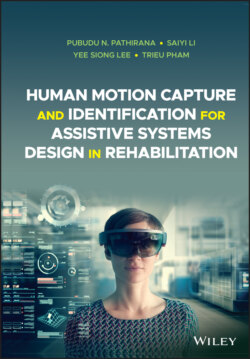Читать книгу Human Motion Capture and Identification for Assistive Systems Design in Rehabilitation - Pubudu N. Pathirana - Страница 19
1.3.2 RGB camera and microphone
ОглавлениеApart from Kinect, conventional RGB cameras and microphones are also pervasively used, especially in the early stages of the history of telerehabilitation when virtual reality devices had not been well developed and pervasively utilised. One of the potential reasons is that they are easy to install and are cost‐effective and well‐developed.
In the early stages of the development of telerehabilitation, the plain old telephone system (POTS) was widely used as the infrastructure of videoconferencing, which was sufficient to provide a teleconsultation. Delaplain et al. [93] made a pioneering trial between two islands to conduct 59 medical tele‐consultations in the form of a videoconference. In this trial, diagnostic and therapeutic decisions were made in a number of specialities, including physical therapy. This is deemed to be one of the first examples of applying videoconferencing in telerehabilitation (although, at that time, the word “telerehabilitation” had not been invented) with cameras and microphones. Its success illustrates the feasibility of using a videoconference in telerehabilitation. Later, in 2002, Clark et al. [72] successfully managed a teletherapy case for 17 months. In this case, a POTS was set up between the therapist's site with a desktop videophone and Mrs M's home with a traditional telephone and a television to provide post‐stroke telerehabilitation services in the form of a two‐way interactive videoconference. However, the lesson learnt from the case is that the use of this novel approach has a number of requirements for the patients, as well as the caregiver, which may be a potential issue in developing telerehabilitation systems in the future. As a conclusion, they mentioned that although telerehabilitation cannot totally replace the conventional way to deliver rehabilitation services, it indeed contributes to traditional therapy. Furthermore, Savard et al. [316] reported two cases of using a videoconference to provide a teleconsultation service for neurological diagnoses. Different from the previous two studies where the videoconference systems were utilised by patients at home, the systems in Savard et al. [316] were installed in clinics. Therefore, patients had to visit the clinics in order to use these facilities. Although it was found that the time taken for a tele‐consultation was similar to an in‐person consultation, the former was more efficient as multiple parties were able to participate in the consultation simultaneously. However, completing remote tests for clinicians would be an important factor that gives telerehabilitation an advantage.
Table 1.3 Comparison of basic technical specifications between two versions of Kinects. Sources: Based on Sempena et al. [322]; https://medium.com/@lisajamhoury/understanding-kinect-v2-joints-and-coordinate-system-4f4b90b9df16microsoft.kinect.jointtype.aspx. Accessed: 2015-05-22.
| Version 1 [322] | Version 2 [4] | |
|---|---|---|
| Viewing angle (vertical) | 43° | 70° |
| Viewing angle (horizontal) | 57° | 60° |
| Vertical tilt range | ±28° | no |
| Frame rate (frame per second) | 30 | 30 |
| Depth resolution (pixels) | 320 × 240 | 512 × 424 |
| Colour stream resolution (pixels) | 640 × 480 | 1920 × 1080 |
| Skeleton | [6] | [3] |
| Number of tracking subjects | 6 (can only display 2) | 6 (can display 6) |
| Sensing principle |
With the advancement of the Internet and computers to deliver telerehabilitation services, POTS was gradually replaced. Russell et al. set up an Internet‐based computer system in two separate rooms in a clinic to evaluate the feasibility of using a videoconference to assess the kinematic gait [308] by evaluating the performance of measuring knee angles via the Internet, called an Internet‐based goniometer (IBG), against the traditional face‐to‐face approach. The interface of the software is shown in Figure 1.7(a). As a conclusion of the experiment, the IBG was found to be comparable to the universal goniometer (UG) in terms of intra‐ and inter‐rater reliability. After that, the same setup was used the following year to provide tele‐medicine to patients after a total knee replacement [309]. This modern method of delivering a rehabilitation service was welcomed by both therapists and patients since it was safe, easy to use and could be integrated into daily clinical practice. More importantly, the outcome of using this approach was similar to a traditional rehabilitation method. Another example is that video cameras were used by Lemaire [204] in a tele‐health program to provide tele‐consultation and education services for various disorders. The majority of the patients accessing this service were satisfied with telerehabilitation. Though the study also found that the time taken for tele‐consultation was similar to a traditional approach, the majority of the therapists agreed that the tele‐health was easy to use and they were confident of the assessment results done with tele‐health. However, as it was in 2000, not all hospitals could afford brand new computers. Therefore, it was critical to develop a low‐cost telerehabilitation system so that everyone could afford it.
Figure 1.7 The physiotherapist monitoring the exercise on his patient remotely through the Internet [308]. Source: Russell et al. [308].
Figure 1.8 Pictures of animals. Sources: (a) Xsens; (b) Amazon; (c) MotionNode.
